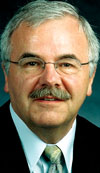
Replacing analogue 4-20 mA technology with a digital network was a major driver behind the development of Foundation Fieldbus technology. However, what really differentiates Foundation Fieldbus from Profibus PA, HART, and other process automation technologies, is the incorporation of a function block structure and other supporting functions that make Foundation technology a complete infrastructure for process automation.
By allowing control functionality to be embedded in the field devices themselves, Foundation Fieldbus enables a degree of availability that approaches that of single-loop controllers. By distributing the control functions out to field-mounted actuators or measurement devices, there is no single point of failure in the system above the H1 level. Thus, even if a failure should occur in the HMI or plant network, the field-based control loops can continue to function. A backup link active scheduler (BLAS) can also be used to enable a field control loop to continue functioning even if there is a failure in the primary LAS. What is more, in cases where control normally resides in the DCS, field-level control can add another level of redundancy. Many end users have already managed to avoid unplanned downtime when field-level control took over after a failure in the DCS.
Evidence suggests that control in the field provides an 80% increase in meantime between failures compared to traditional DCS control. The increased MTBF combined with the reduction in data transfers required, substantially increases reliability and availability. The overall reduction in network traffic (even with the increased device condition, status, and other data typically passed from fieldbus devices to the DCS) also increases network availability.
In addition to increasing availability and reliability, field-level control also increases flexibility. With basic loop control performed in the field devices, dedicated process controllers can be freed up to handle higher-level functions, such as advanced control and optimisation. Foundation Fieldbus allows for ‘dynamically instantiable function blocks’. This means that users can activate function blocks in different components of the system as required. In addition to basic PID control blocks, users also have access to a large library of other block types. These include switches, alarms, and so on.
Foundation Fieldbus adoption has skyrocketed over the past several years, particularly in the power and HPI industries. ARC estimates that the total market for fieldbus products and services is rapidly approaching a billion dollars. Users that actually implement the control in the field functionality, however, still represent a small minority.
In ARC’s view, the reason most users do not take advantage of control in the field is due to the perception that it compromises reliability and availability, and provides little direct economic impact or business value proposition to the manufacturing enterprise. The reality is far different.
Until recently, there had been no comprehensive study that proved the business value proposition of control in the field. Most of the evidence was anecdotal. The results of real world control in the field applications, however, show that control in the field can provide a path to single loop integrity and truly distributed control for many flow and pressure loops in a process plant or mill.
Recently, UK-based, Industrial Systems and Control (ISC, www.isc-ltd.com) released a study called, ‘Control in the Field: Analysis of Performance Benefits'. In a series of illustrative simulation studies, ISC determined that control in the field has the potential to offer improved control loop performance due to its ability to offer faster sample rates and shorter latencies in the read-execute-write cycle of a control loop. ISC examined the differences in timing and sequencing associated with control in the field versus a scheme employing control in the DCS to establish typical latencies and sample rates that limit control performance. ISC tested many different scenarios and process dynamics and the report outlines the results and corresponding benefits. While all control in the field loops can benefit from increased integrity, flexibility, and reliability, ISC found that control loop performance benefits can be quite significant in fast process loops.
Larry O’Brien, research director, Process Automation

Larry’s focus areas at ARC include process automation solutions, fieldbus networks, distributed control systems, and automation services. Larry tracks the market for process automation systems (PAS) and has authored the PAS market studies for ARC since 1998. He has also authored many other market research, strategy, and custom research reports on a range of automation-related topics. Larry, who has been with ARC since 1995, has a BA from the University of Massachusetts at Lowell.
Dick Hill, VP and GM, Manufacturing Advisory Services

Part of the management team at ARC, Dick is responsible for developing the strategic direction for ARC products and services. Dick covers advanced software business on a worldwide basis. Dick has over 30 years of experience in manufacturing and automation. As a process engineer, he gained experience in oil refinery operations and APC applications. Later, he expanded this knowledge of manufacturing solutions applied to other process industries. Dick, who has been with ARC since 1995, is a graduate of Lowell Technological Institute with a BS in Chemical Engineering. He has completed post-graduate courses in network technologies and relational database structures at Northeastern University.
For more information contact Larry O’Brien, ARC Advisory Group, (+1) 781 471 1126, [email protected], www.arcweb.com
| Tel: | +27 11 548 9960 |
| Email: | [email protected] |
| www: | www.profiafrica.co.za |
| Articles: | More information and articles about PI SA (PROFIBUS & PROFINET SA) |
© Technews Publishing (Pty) Ltd | All Rights Reserved